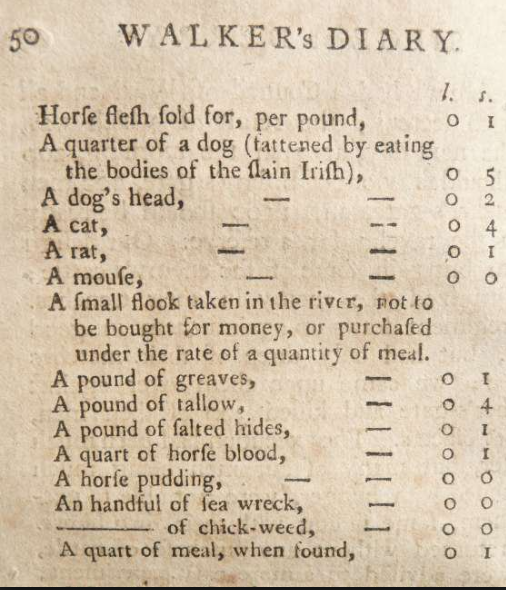Hearth Money Rolls 1660s
The hearth tax was the first of a new wave of taxes brought in shortly after the restoration of King Charles II in 1662 and continued for 27 years until 1689. Collected twice yearly at Michelmas (29th September) and Ladys Day (25th March) copies of the returns of payments were sent to the exchequer and to the local Quarter Sessions. The first Hearth Money Act was passed in the Irish Parliament in 1662. It provided that 2 shillings should be paid on every hearth or ‘other place used for firing’. Arranged by county, parish and, usually, townland, the Hearth Money Rolls list the names of householders who were liable to pay tax at the rate of two shillings on every hearth or fireplace they had. Some people were exempt from the tax and, of course, others managed to evade paying it.The lists are not a complete record of every householder in a townland. Those exempt included persons living on alms, or persons not able to work, or persons who had a house or lands worth less than eight pounds per annum and with property valued at less than four pounds.
The tax was collected over areas known as ‘Walks’ and based on the town. The ‘Lisburn Walk’, for example, covered a large area of the south of Co. Antrim and not merely Lisburn town. The "Dunluce Walk" in County Antrim was centred on the town of Dunluce which was just outside the castle. It covered the baronies of Cary, Dunluce and Kilconway in North Antrim as well as the baronies of Coleraine and North East Liberties in County Londonderry.
The original Hearth Money Rolls were destroyed by fire in the Four Courts, Dublin in 1922. However, the Presbyterian Historical Society of Ireland had made copies of the Rolls and these were lent to PRONI in the mid-1920s for copying. This clearly has implications for the spelling of both personal names and townland names as the copies are transcripts of transcripts. Nevertheless, the HMR is a valuable census substitute for the seventeenth century.
Co. Antrim
1666 HMR T/3022/4/1
1669 HMR T/307/A
Co. Armagh
1664 HMR T/604
1664 & 1665 HMR T/808/14950
1664-1665 HMR T/3839/1 (Shankill Parish only)
Co. Fermanagh
1665-1666 HMR T/808/15066-15068;T/265
Barony of Lurg, Town of Enniskillen and parish of Devenish (extracts)
Co. Londonderry
1663 HMR T/307/A; T/716/4
1663 HMR D/4164/A/14 (Coleraine Parish only)
Co. Tyrone
1663-1664 HMR T/283/D/2; T/458/1; T/1365/3; MIC/645
1664 and 1666 HMR MIC/645
1665-1666 HMRl T/458/1 [Dungannon Barony only]
1666 HMR T/307/A - C; T/716/16
Co Cavan
1664 HMR T/808/15142
[Urney, Annagh, Annagelliff, Templeport and Kildallan Parishes and Cavan Borough]
Co. Donegal
1665 HMR T/307/D; T/283/D/3; T/296/1
Co. Monaghan
1663 and 1666 HMR T/808/15156
The tax was collected over areas known as ‘Walks’ and based on the town. The ‘Lisburn Walk’, for example, covered a large area of the south of Co. Antrim and not merely Lisburn town. The "Dunluce Walk" in County Antrim was centred on the town of Dunluce which was just outside the castle. It covered the baronies of Cary, Dunluce and Kilconway in North Antrim as well as the baronies of Coleraine and North East Liberties in County Londonderry.
The original Hearth Money Rolls were destroyed by fire in the Four Courts, Dublin in 1922. However, the Presbyterian Historical Society of Ireland had made copies of the Rolls and these were lent to PRONI in the mid-1920s for copying. This clearly has implications for the spelling of both personal names and townland names as the copies are transcripts of transcripts. Nevertheless, the HMR is a valuable census substitute for the seventeenth century.
Co. Antrim
1666 HMR T/3022/4/1
1669 HMR T/307/A
Co. Armagh
1664 HMR T/604
1664 & 1665 HMR T/808/14950
1664-1665 HMR T/3839/1 (Shankill Parish only)
Co. Fermanagh
1665-1666 HMR T/808/15066-15068;T/265
Barony of Lurg, Town of Enniskillen and parish of Devenish (extracts)
Co. Londonderry
1663 HMR T/307/A; T/716/4
1663 HMR D/4164/A/14 (Coleraine Parish only)
Co. Tyrone
1663-1664 HMR T/283/D/2; T/458/1; T/1365/3; MIC/645
1664 and 1666 HMR MIC/645
1665-1666 HMRl T/458/1 [Dungannon Barony only]
1666 HMR T/307/A - C; T/716/16
Co Cavan
1664 HMR T/808/15142
[Urney, Annagh, Annagelliff, Templeport and Kildallan Parishes and Cavan Borough]
Co. Donegal
1665 HMR T/307/D; T/283/D/3; T/296/1
Co. Monaghan
1663 and 1666 HMR T/808/15156



My name is Jane Berryman well its Laurél Jane Berryman now Bailey I am trying to find my grandfather my fathers dad which i was told was John A. Berryman mother I believe her name to be sarah? But my grandfather passed away just two years before I was born in 1970 my father is Melvin James Berryman born 08/19/1922 so that’s what I’m told although he looks like he’s still in his 60 s at age 86 my mother looks way younger than she says also a n d I’m atarting to wonder if they both are lying about their births to conseal the past smh i need to know please anyone call me four four zero eight nine eight four one 2 seven thank you
ReplyDeleteMy suggestion is to do a DNA test and start looking at your matches and see how they fit. Many Facebook genealogy pages will help you.
Delete